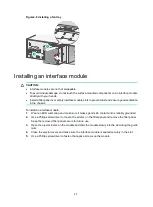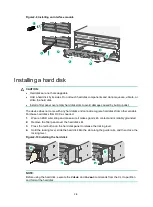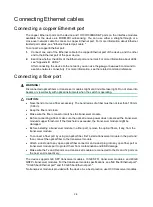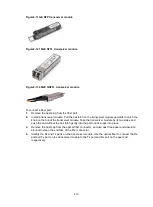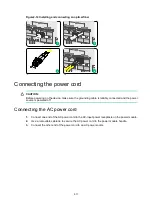
1-3
•
Make sure the accessories of the device are not lost or damaged during device moving.
Examining the installation site
The device can only be used indoors. To ensure correct operation and a long lifespan for your device,
the installation site must meet the following requirements.
Weight support
Make sure the floor can support the total weight of the rack, chassis, modules, and all other
components. For weights of the chassis and components, see "Appendix A Chassis views and
technical specifications."
Temperature and humidity
Maintain temperature and humidity in the equipment room at levels as described in
•
Lasting high relative humidity can cause poor insulation, electricity leakage, mechanical
property change of materials, and metal corrosion.
•
Lasting low relative humidity can cause washer contraction and ESD and bring problems
including loose captive screws and circuit failure.
•
High temperature can accelerate the aging of insulation materials and significantly lower the
reliability and lifespan of the device.
Table1-2 Temperature and humidity requirements
Item
Specification
Temperature
•
Operating:
Without hard disks: 0°C to 45°C (32°F to 113°F)
With hard disks: 5°C to 40°C (41°F to 104°F)
•
Storage: –40°C to +70°C (–40°F to +158°F)
Humidity
•
Operating:
Without hard disks: 5% RH to 95% RH, noncondensing
With hard disks: 10% RH to 80% RH, noncondensing
•
Storage:
Without hard disks: 5% RH to 95% RH, noncondensing
With hard disks: 5% RH to 90% RH, noncondensing
Cleanliness
Dust buildup on the chassis might result in electrostatic adsorption, which causes poor contact of
metal components and contact points, especially when indoor relative humidity is low. In the worst
case, electrostatic adsorption can cause communication failure.
Table1-3 Dust concentration limit in the equipment room
Substance
Concentration limit (particles/m
3
)
Dust particles
≤ 3 × 10
4
(No visible dust on desk in three days)
NOTE:
Dust
particle diameter ≥ 5 µm





















